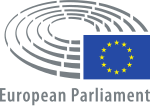
The European Parliament (EP) is one of the two legislative bodies of the European Union and one of its seven institutions. Together with the Council of the European Union, it adopts European legislation, following a proposal by the European Commission. The Parliament is composed of 720 members (MEPs), after the June 2024 European elections, from a previous 705 MEPs. It represents the second-largest democratic electorate in the world, with an electorate of around 375 million eligible voters in 2024.

The Treaty on European Union, commonly known as the Maastricht Treaty, is the foundation treaty of the European Union (EU). Concluded in 1992 between the then-twelve member states of the European Communities, it announced "a new stage in the process of European integration" chiefly in provisions for a shared European citizenship, for the eventual introduction of a single currency, and for common foreign and security policies, and a number of changes to the European institutions and their decision taking procedures, not least a strengthening of the powers of the European Parliament and more majority voting on the Council of Ministers. Although these were seen by many to presage a "federal Europe", key areas remained inter-governmental with national governments collectively taking key decisions. This constitutional debate continued through the negotiation of subsequent treaties, culminating in the 2007 Treaty of Lisbon.
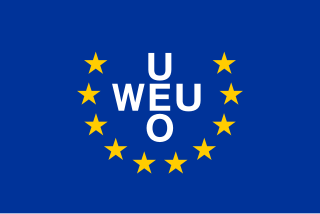
The Western European Union was the international organisation and military alliance that succeeded the Western Union (WU) after the 1954 amendment of the 1948 Treaty of Brussels. The WEU implemented the Modified Brussels Treaty. During the Cold War, the Western Bloc included the WEU member-states, plus the United States and Canada, as part of the North Atlantic Treaty Organization (NATO).

The Treaty on European Union (2007) is one of the primary Treaties of the European Union, alongside the Treaty on the Functioning of the European Union (TFEU). The TEU forms the basis of EU law, by setting out general principles of the EU's purpose, the governance of its central institutions, as well as the rules on external, foreign and security policy.

The Treaty of Nice was signed by European leaders on 26 February 2001 and came into force on 1 February 2003.
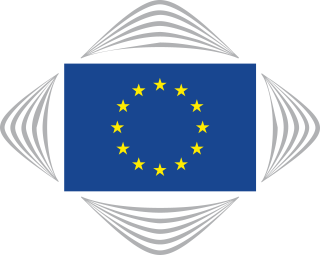
The European Committee of the Regions (CoR) is the European Union's (EU) assembly of local and regional representatives that provides sub-national authorities with a direct voice within the EU's institutional framework.

An entity to be named the European Political Community (EPC) was proposed in 1952 as a combination of the existing European Coal and Steel Community (ECSC) and the proposed European Defence Community (EDC). A draft EPC treaty, as drawn up by the ECSC assembly, would have seen a directly elected assembly, a senate appointed by national parliaments and a supranational executive accountable to the parliament.

The Treaty of Amsterdam, officially the Treaty of Amsterdam amending the Treaty on European Union, the Treaties establishing the European Communities and certain related acts, was signed on 2 October 1997, and entered into force on 1 May 1999; it made substantial changes to the Treaty of Maastricht, which had been signed in 1992.

Between 1993 and 2009, the European Union (EU) legally comprised three pillars. This structure was introduced with the Treaty of Maastricht on 1 November 1993, and was eventually abandoned on 1 December 2009 upon the entry into force of the Treaty of Lisbon, when the EU obtained a consolidated legal personality.
- The European Communities pillar handled economic, social and environmental policies. It comprised the European Community (EC), the European Coal and Steel Community, and the European Atomic Energy Community (EURATOM).
- The Common Foreign and Security Policy (CFSP) pillar took care of foreign policy and military matters.
- Police and Judicial Co-operation in Criminal Matters (PJCCM) brought together co-operation in the fight against crime. This pillar was originally named Justice and Home Affairs (JHA)

The political structure of the European Union (EU) is similar to a confederation, where many policy areas are federalised into common institutions capable of making law; the competences to control foreign policy, defence policy, or the majority of direct taxation policies are mostly reserved for the twenty-seven state governments. These areas are primarily under the control of the EU's member states although a certain amount of structured co-operation and coordination takes place in these areas. For the EU to take substantial actions in these areas, all Member States must give their consent. Union laws that override State laws are more numerous than in historical confederations; however, the EU is legally restricted from making law outside its remit or where it is no more appropriate to do so at a state or local level (subsidiarity) when acting outside its exclusive competences. The principle of subsidiarity does not apply to areas of exclusive competence.
The Davignon report, also referred to as the Luxembourg report, published on 27 October 1970, was a report on the future foreign policy of European Economic Community member nations. It was written by a council chaired by Étienne Davignon of the Belgian Foreign Office. The committee was appointed by the Council of the European Communities to make proposals on political cooperation between the member states. It recommended that member states should try to speak with a single voice on international problems, a proposal that was approved by all six member governments. It resulted first in European Political Cooperation and later in the European Union's Common Foreign and Security Policy in 1992.

The Conference of Parliamentary Committees for Union Affairs of Parliaments of the European Union (COSAC) is a conference of Members of the European Parliament (MEPs) and national Members of Parliament (MPs) who are drawn from parliamentary committees responsible for European Union affairs.
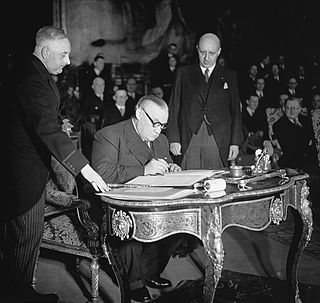
The Treaty of Brussels, also referred to as the Brussels Pact, was the founding treaty of the Western Union (WU) between 1948 and 1954, when it was amended as the Modified Brussels Treaty (MTB) and served as the founding treaty of the Western European Union (WEU) until its termination in 2010. The treaty provided for the organisation of military, economic, social and cultural cooperation among member states as well as a mutual defence clause.
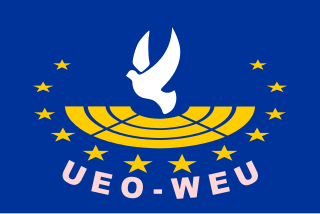
The Assembly of the Western European Union, also called the European Security and Defence Assembly, was a parliamentary assembly for delegations from the national parliaments of the member countries of the Western European Union (WEU), a security and defence organisation. Its final session was on 10 May 2011.
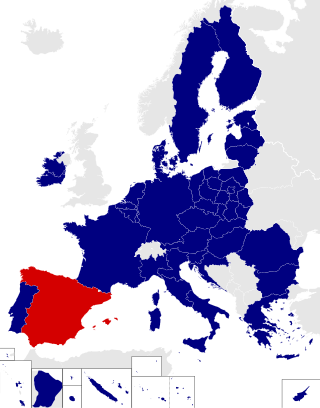
Spain is a European Parliament constituency for elections in the European Union covering the member state of Spain. It is currently represented by 61 Members of the European Parliament and is the second largest European Parliament constituency in terms of geographic area after France, as well as the third most populated after Germany and France.

The Treaty of Lisbon is an international agreement that amends the two treaties which form the constitutional basis of the European Union (EU). The Treaty of Lisbon, which was signed by all EU member states on 13 December 2007, entered into force on 1 December 2009. It amends the Maastricht Treaty (1992), known in updated form as the Treaty on European Union (2007) or TEU, as well as the Treaty of Rome (1957), known in updated form as the Treaty on the Functioning of the European Union (2007) or TFEU. It also amends the attached treaty protocols as well as the Treaty establishing the European Atomic Energy Community (EURATOM).
The Interparliamentary EU information exchange (IPEX), is a platform for the exchange of information between EU national parliaments as well as the European Parliament concerning issues related to the European Union, especially in light of the provisions of the Treaty of Lisbon. The Treaty of Lisbon explicitly sets out the role of the national parliaments in the "Protocol on the role of national Parliaments in the European Union" and in the "Protocol on the application of the principles of subsidiarity and proportionality".
The Committee on European Affairs and Oversight of the European Funds (CEAOEF) is one of the 17 standing committees in the 41st National Assembly of the Republic of Bulgaria.

Monika Panayotova is a Doctor of Political Science, with interests in the field of the EU security and defence policy. Bulgarian politician – Monika Panayotova has been appointed as Deputy Minister for the Bulgarian Presidency of the Council of the EU 2018, responsible for the relations with the European Parliament during the Bulgaria's presidency since June 28, 2017.

This is the results breakdown of the European Parliament election held in Spain on 26 May 2019. The following tables show detailed results in each of the country's 17 autonomous communities and in the autonomous cities of Ceuta and Melilla.



















